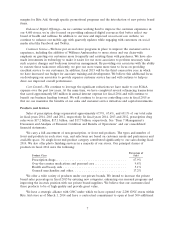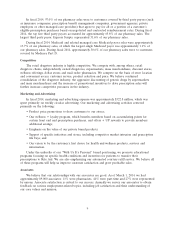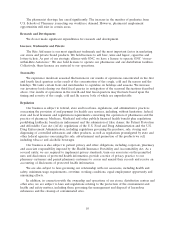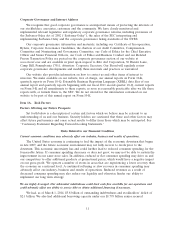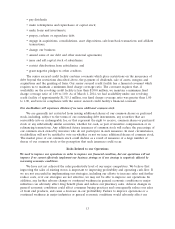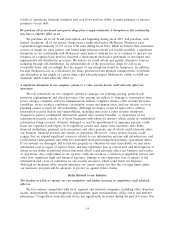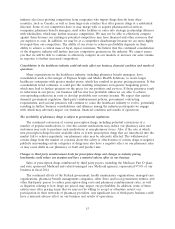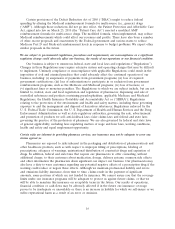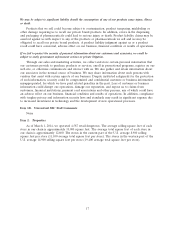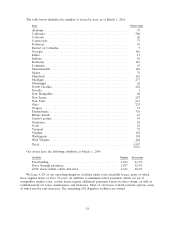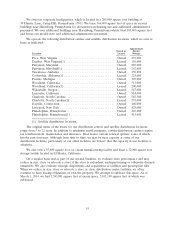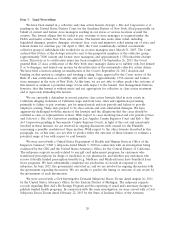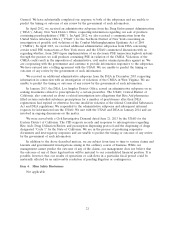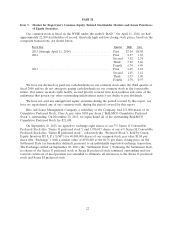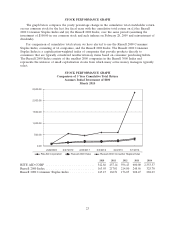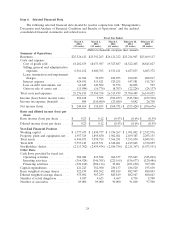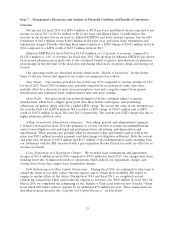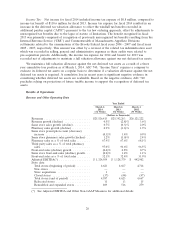Rite Aid 2014 Annual Report Download - page 17
Download and view the complete annual report
Please find page 17 of the 2014 Rite Aid annual report below. You can navigate through the pages in the report by either clicking on the pages listed below, or by using the keyword search tool below to find specific information within the annual report.Certain provisions of the Deficit Reduction Act of 2005 (‘‘DRA’’) sought to reduce federal
spending by altering the Medicaid reimbursement formula for multi-source (i.e., generic) drugs
(‘‘AMP’’). Although those reductions did not go into effect, the Patient Protection and Affordable Care
Act, signed into law on March 23, 2010 (the ‘‘Patient Care Act’’) enacted a modified AMP
reimbursement formula for multi-source drugs. The modified formula, when implemented, may reduce
Medicaid reimbursements which could affect our revenues and profits. There have also been a number
of other recent proposals and enactments by the Federal government and various states to reduce
Medicare Part D and Medicaid reimbursement levels in response to budget problems. We expect other
similar proposals in the future.
We are subject to governmental regulations, procedures and requirements; our noncompliance or a significant
regulatory change could adversely affect our business, the results of our operations or our financial condition.
Our business is subject to numerous federal, state and local laws and regulations (‘‘Regulations’’).
Changes in these Regulations may require extensive system and operating changes that may be difficult
to implement. Untimely compliance or noncompliance with applicable Regulations could result in the
imposition of civil and criminal penalties that could adversely affect the continued operation of our
business, including: (i) suspension of payments from government programs; (ii) loss of required
government certifications; (iii) loss of authorizations to participate in or exclusion from government
reimbursement programs, such as the Medicare and Medicaid programs; (iv) loss of licenses; or
(v) significant fines or monetary penalties. The Regulations to which we are subject include, but are not
limited to, federal, state and local registration and regulation of pharmacies; dispensing and sale of
controlled substances and products containing pseudoephedrine; applicable Medicare and Medicaid
Regulations; the Health Insurance Portability and Accountability Act or (‘‘HIPAA’’); Regulations
relating to the protection of the environment and health and safety matters, including those governing
exposure to and the management and disposal of hazardous substances; Regulations enforced by the
U. S. Federal Trade Commission, the U. S. Department of Health and Human Services and the Drug
Enforcement Administration as well as state regulatory authorities, governing the sale, advertisement
and promotion of products we sell; anti-kickback laws; false claims laws and federal and state laws
governing the practice of the profession of pharmacy. We are also governed by federal and state laws
of general applicability, including laws regulating matters of wage and hour laws, working conditions,
health and safety and equal employment opportunity.
Certain risks are inherent in providing pharmacy services; our insurance may not be adequate to cover any
claims against us.
Pharmacies are exposed to risks inherent in the packaging and distribution of pharmaceuticals and
other healthcare products, such as with respect to improper filling of prescriptions, labeling of
prescriptions, adequacy of warnings, unintentional distribution of counterfeit drugs and expiration of
drugs. In addition, federal and state laws that require our pharmacists to offer counseling, without
additional charge, to their customers about medication, dosage, delivery systems, common side effects
and other information the pharmacists deem significant can impact our business. Our pharmacists may
also have a duty to warn customers regarding any potential negative effects of a prescription drug if the
warning could reduce or negate these effects. Although we maintain professional liability and errors
and omissions liability insurance, from time to time, claims result in the payment of significant
amounts, some portions of which are not funded by insurance. We cannot assure you that the coverage
limits under our insurance programs will be adequate to protect us against future claims, or that we
will be able to maintain this insurance on acceptable terms in the future. Our results of operations,
financial condition or cash flows may be adversely affected if in the future our insurance coverage
proves to be inadequate or unavailable or there is an increase in liability for which we self-insure or we
suffer reputational harm as a result of an error or omission.
16



